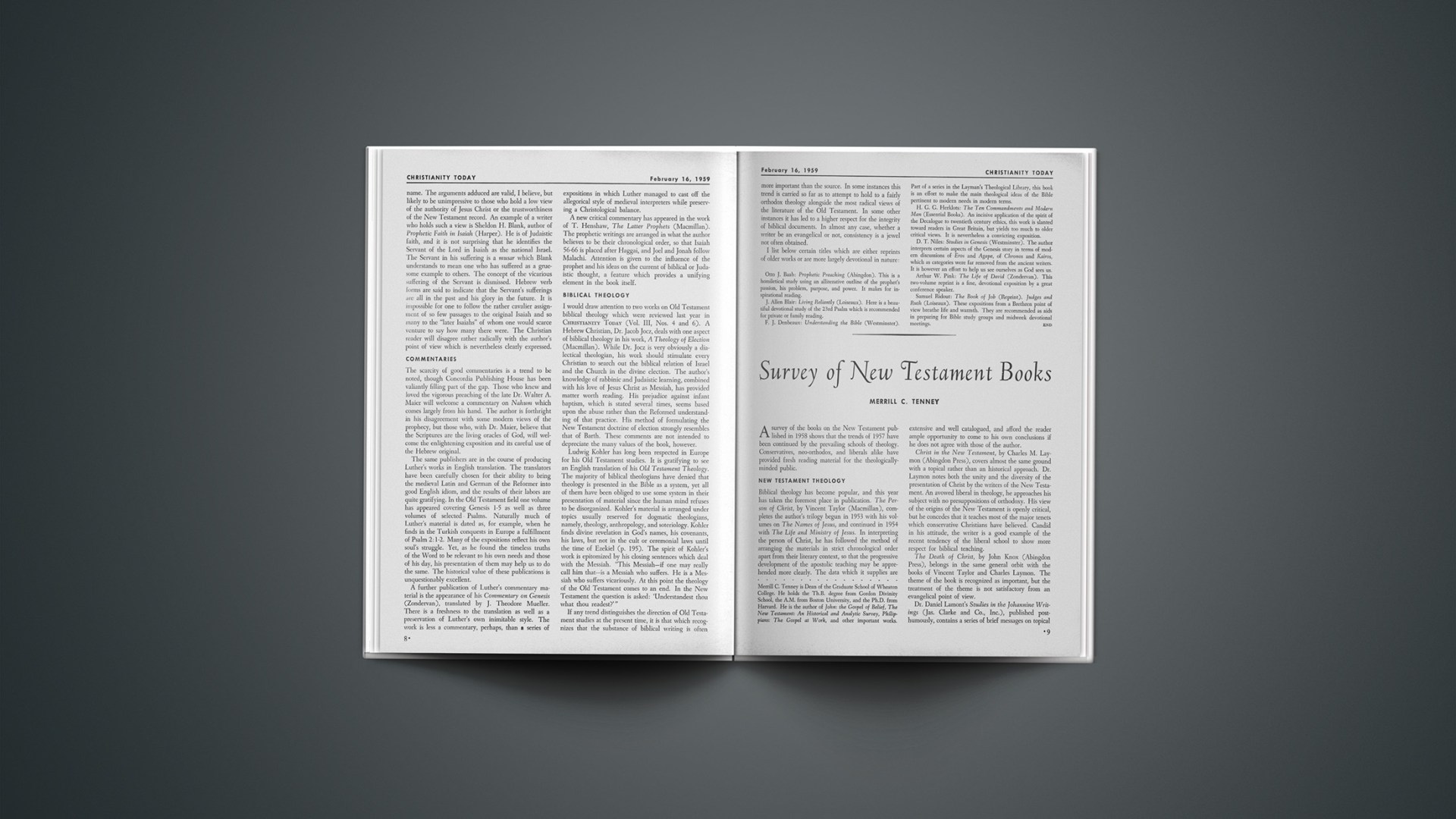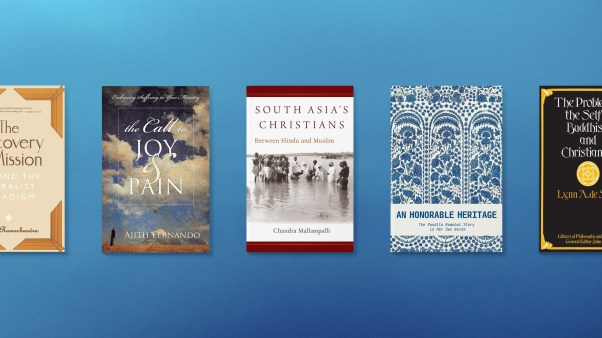A survey of the books on the New Testament published in 1958 shows that the trends of 1957 have been continued by the prevailing schools of theology. Conservatives, neo-orthodox, and liberals alike have provided fresh reading material for the theologically-minded public.
New Testament Theology
Biblical theology has become popular, and this year has taken the foremost place in publication. The Person of Christ, by Vincent Taylor (Macmillan), completes the author’s trilogy begun in 1953 with his volumes on The Names of Jesus, and continued in 1954 with The Life and Ministry of Jesus. In interpreting the person of Christ, he has followed the method of arranging the materials in strict chronological order apart from their literary context, so that the progressive development of the apostolic teaching may be apprehended more clearly. The data which it supplies are extensive and well catalogued, and afford the reader ample opportunity to come to his own conclusions if he does not agree with those of the author.
Christ in the New Testament, by Charles M. Laymon (Abingdon Press), covers almost the same ground with a topical rather than an historical approach. Dr. Laymon notes both the unity and the diversity of the presentation of Christ by the writers of the New Testament. An avowed liberal in theology, he approaches his subject with no presuppositions of orthodoxy. His view of the origins of the New Testament is openly critical, but he concedes that it teaches most of the major tenets which conservative Christians have believed. Candid in his attitude, the writer is a good example of the recent tendency of the liberal school to show more respect for biblical teaching.
The Death of Christ, by John Knox (Abingdon Press), belongs in the same general orbit with the books of Vincent Taylor and Charles Laymon. The theme of the book is recognized as important, but the treatment of the theme is not satisfactory from an evangelical point of view.
Dr. Daniel Lamont’s Studies in the Johannine Writings (Jas. Clarke and Co., Inc.), published posthumously, contains a series of brief messages on topical aspects of theology in the Gospel, Epistles, and Revelation. His volume is less technical and theological than the three preceding titles, but it possesses a rare biographical fragrance that makes the teaching winsome. It will serve as a “starter” for many sermons.
The late Clarence E. Macartney’s small volume, What Jesus Really Taught (Abingdon Press), is also posthumous, and, as might be expected, conservative in theology. This little book contains short summaries of Jesus’ teaching on God, the Holy Spirit, Man, the Kingdom, Money, Marriage, and other kindred topics. The treatment is thoroughly popular, and abounds in excellent illustrations.
H. N. Ridderbos’ Paul and Jesus (Presbyterian and Reformed) discusses the relation of Paul’s thinking to Christ. The theme is old, but the treatment is new. Thoroughly in accord with Reformed theology, Dr. Ridderbos strengthens the case for the validity of the Pauline Christology.
Translations
Two new translations of the New Testament have appeared this year. One is the second volume of The Expanded Translation of the New Testament by Kenneth Wuest (Eerdmans), covering Acts through Ephesians. This translation is really a paraphrase which constitutes a brief commentary. Many of the renderings are apt, and the tenses of verbs are well handled, though sometimes the sentences are circuitous. The vocabulary is occasionally colloquial, but never ambiguous.
The second translation is The Amplified New Testament (Zondervan), produced by an anonymous editorial committee. Less bulky than Wuest’s translation, this work follows more closely the order of the original text, and may be used for direct reading and study. Insertions and expansions are indicated by the use of parentheses and square brackets, with occasional footnotes to supply textual emendations or to acknowledge sources. It is readable, accurate, and free from extreme renderings, flexible enough to be modern and dignified enough to retain the atmosphere of the original.
Commentaries
A new series of commentaries has been launched cooperatively by A. and C. Black in England and by Harper in this country. The volume on Acts, by C. S. C. Williams, was published last year, and this year C. K. Barrett’s Commentary on the Epistle to the Romans and A. R. C. Leaney’s Commentary on the Gospel According to Luke have been completed. Both are of moderate size (300 pp.), and are concise and thorough. Their critical introductions represent the latest thought on the background of the biblical books of which they treat. Leaney takes a somewhat more radical attitude on Luke than Barrett does on Romans, and is less theological in his interpretation.
C. C. Martindale has published commentaries on Matthew, Luke, John, and the Revelation (Longmans) from the Roman Catholic point of view. Among the conservative Protestants are R. V. G. Tasker on II Corinthians (Eerdmans), Homer Kent on the Pastoral Epistles (Moody Press), L. L. Morris on I Corinthians, and Donald Guthrie on The Pastoral Epistles in the Tyndale Bible Commentaries, and another volume in The New International Commentary Series on Ephesians and Colossians by E. K. Simpson and F. F. Bruce (all Eerdmans). This last commentary maintains the high standard set by its predecessors, and is suited both for popular and scholarly use. They Met at Philippi by C. E. Simcox (Oxford Press), is a homiletical treatment of the text of Philippians rather than a critical commentary.
The wide publication of books and articles on the Qumran Scrolls has raised so many questions in the minds of the public that books are now being written to answer them. Two lucid and helpful guides have appeared, one by three English authors, and one by an American author. A Guide to the Scrolls, by A. R. C. Leaney, R. P. C. Hanson, and J. Posen (S.C.M. Book Club) is brief, well outlined, and planned for the reader who is not a professional scholar. Carl G. Howie, a Presbyterian pastor, has written The Dead Sea Scrolls and The Living Church (John Knox Press), a volume quite similar in size and in design, to reassure readers who think that the material in the scrolls has endangered historic Christianity. Both books can be commended for their brevity and directness. They make a confusing subject clear.
Frank Cross, Jr., has produced a somewhat more technical volume, The Ancient Library of Qumran and Modern Biblical Studies (Doubleday). Dr. Cross’ work represents firsthand scholarship, since he has worked on the scrolls, and his statements are authoritative.
New Testament Introduction
Some material on New Testament Introduction is supplied by C. K. Barrett, The New Testament: Its Making and Meaning (Abingdon Press), and B. W. Blackwelder, Light from the Greek New Testament. A very handy little introduction by L. D. Twilley, The Origin and Transmission of the New Testament, appeared late in 1957 in the Pathway Series (Eerdmans). It contains some unusually helpful and original charts illustrating the writing and copying of the manuscripts of the New Testament. Twilley follows Streeter’s theory of geographical centers for the different types of text in the manuscript tradition. Not everybody will agree with this theory, nor with his acceptance of the documentary theory of Gospel origins, but he has produced in small compass one of the best integrated accounts of the rise of the New Testament in circulation today.
Reprints
Two reprints of old standard texts have been issued this year. Eadie’s Colossians, a thorough exegetical commentary, was published by Zondervan, and Alford’s Greek Testament, edited by Everett Harrison, has been revised in two large volumes by Moody Press. The revisions of Alford are not extensive, and are massed in additional pages at the end of each volume. Alford still contains much that is valuable, although the more recent commentaries have superseded many of its interpretations of vocabulary.
There are one or two miscellaneous titles that deserve special comment. Thomas Nelson’s new Atlas of the Early Christian World belongs more properly to the field of church history than to New Testament exposition, but excellence of planning and of content makes it useful in interpreting the early apostolic period which follows the writing of the New Testament.
Dispensationalism in America by C. Norman Krause (John Knox Press), deals properly with a phase of the history of theology, but touches on the interpretation of the eschatological passages of the New Testament. The author is opposed to the dispensational view, but he states its history with fair objectivity.
This flow of publication in the New Testament field is encouraging to evangelicals. While not all these works are written from their viewpoint, they represent a trend toward letting the Scriptures speak for themselves, and they foster interest in the biblical message.
Merrill C. Tenney is Dean of the Graduate School of Wheaton College. He holds the Th.B. degree from Gordon Divinity School, the A.M. from Boston University, and the Ph.D. from Harvard. He is the author of John: the Gospel of Belief, The New Testament: An Historical and Analytic Survey, Philippians: The Gospel at Work, and other important works.










